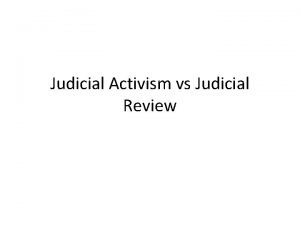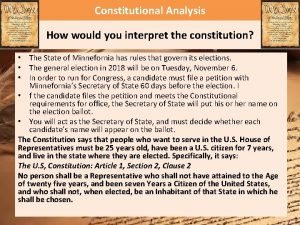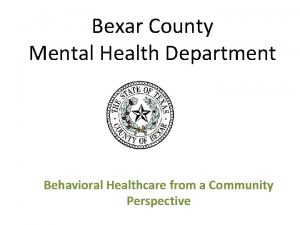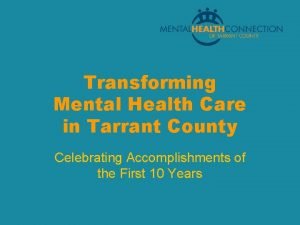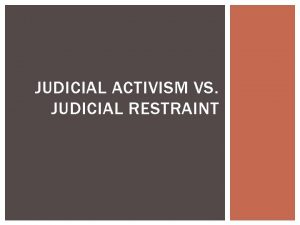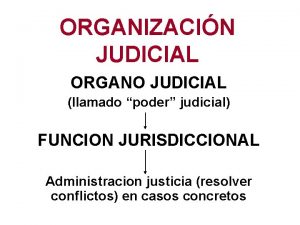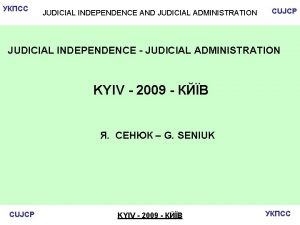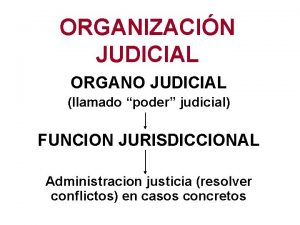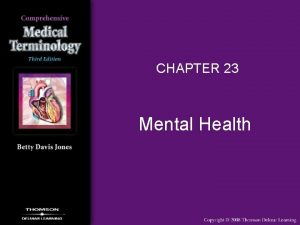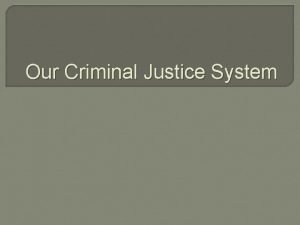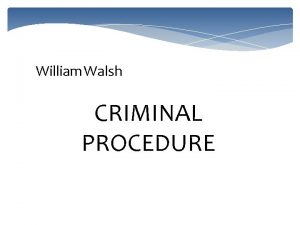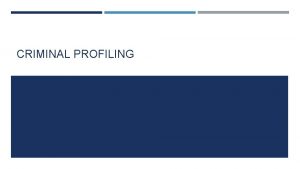ELEVENTH JUDICIAL CRIMINAL MENTAL HEALTH PROJECT MiamiDade County
























- Slides: 24

ELEVENTH JUDICIAL CRIMINAL MENTAL HEALTH PROJECT Miami-Dade County, Florida

Jail Diversion Programs Designed and implemented to divert people with serious mental illnesses away from the criminal justice system into community-based treatment and services

FACTS • There are 800 -1400 detainees that experience mental illness on any given day at the Miami-Dade County jail. • This represents approximately 30% of the total inmate population and costs taxpayers millions of dollars annually to manage this population in jail. • Persons with mental illnesses stay in jail 8 times longer than those individuals without mental illness at a cost of 7 times more.

Cross System Collaboration • • • Judges The Court Public Defender State Attorney Law Enforcement Consumers and Families • Department of Corrections • Mental Health Providers • Social Security • Foundations • DCF Ama

PRE-BOOKING Crisis Intervention Team (CIT) CIT officers receive special training to respond to crisis calls involving persons with suspected mental illness. When appropriate, CIT officers transport individuals with mental illness to community mental health facilities for evaluation, treatment, and referrals instead of making an arrest.

CIT • • • Collaboration between Police and Mental Health Facilities CIT training- experts in the community volunteer to present subject matter Changing Police values about people with mental illnesses Changing working relationships between Police and Mental Health Facilities CIT Advisory Committee

Meeting the Demand • 16 CIT Trainings- 40 hour classes per year • Communications Trainings for dispatchers and call takers • Executive Training for Command Staff • Train the trainers

Pre-Booking CIT • 36 of 36 Police Departments participate in CIT training • More than 4, 700 officers trained since 2003 • More than 1, 200 CIT officers On Duty throughout Miami-Dade County

POST-BOOKING • Originally established to divert nonviolent misdemeanant defendants with SMI and possible cooccurring substance use disorders • Program expanded to serve defendants that have been arrested for less serious felonies and other charges as determined appropriate

Twin Goals § Improve psychiatric outcomes (stabilization, functioning, recovery) in the least restrictive setting § Decrease recidivism

Jail Diversion Programs • Misdemeanor • Felony • Forensic

SSI/SSDI OUTREACH ACCESS RECOVERY (SOAR) • An approach that was developed to access and expedite social security entitlements for individuals that are homeless and mentally ill • Created specialized unit to expedite access to benefits • Expand target population Cas

PEER SPECIALISTS • Due to their life experience they are uniquely qualified to perform the functions of the position. • Peer support specialists work as members of the jail diversion team. • Primary responsibility is to assist jail diversion participants with community reentry and engagement in continuing treatment and services

Successful Community Re-Entry and Recovery • Individuals voluntarily agree to services and are assisted with linkages to a comprehensive array of community-based treatment, support, and housing services • The CMHP utilizes the APIC Model to provide transition planning for all program participants • Upon stabilization, legal charges may be dismissed or modified in accordance with treatment engagement

Treatment Alone is Not Sufficient • Only 1 in 10 offenders with mental illness are arrested as a result of untreated mental illness • Justice involved people with SMI have the same criminal risk factors as anyone else and face an array of challenges- person-level factors and environmental factors

Immediate Access Provide linkage to the necessary treatment and supportive services: • • • Treatment Medication Housing Transportation Entitlements ama

Screening Tools • Mental Health Screening Form III • Ohio Risk Assessment System. Community Supervision Tool • TCU Drug Screen V

Develop Individualized Interventions • • • Medication Adherence Criminogenic Risk- CBT Addiction Risk Trauma Risk Stress Risk Environmental/Social Disadvantage Risks

Assess the Individual Served • Face to face contact by JDP Staff • Needs Assessment includes: – Housing (73% homeless at time of arrest) – Treatment: mental health, substance abuse, trauma, CBT – Culture – Entitlements – Case management – Special needs

Plan for Treatment and Services § Referrals to community services based on individual risks and needs § Initiate contact with Social Security § Address possible gaps • Transportation • Clothing • Identification • Language

Identify Appropriate Community Programs • Forward a complete summary of recommendations and release conditions to community provider • Ensure individual served is aware of community providers responsibility to report status to the court • Ensure individual served has the necessary tools to comply with conditions of release

Coordinate the Transition Plan • Link to Peer Specialists for support during community reentry process – Release – Intake to community provider • Immediate access to community services • Ensure that the individual served knows who to contact for: – Medication issues – Court reporting

Summary • • • Intervention and Support Individualize Transition Planning Cross-System Collaboration Promote Creative Solutions Reduce Jail Recidivism Promote HOPE and RECOVERY

For Additional Information Cindy A. Schwartz, MS, MBA Project Director cischwartz@jud 11. flcourts. org
 Bidsync miami dade
Bidsync miami dade Nicki brisson
Nicki brisson Judicial restraint
Judicial restraint Judicial restraint vs judicial activism
Judicial restraint vs judicial activism Judicial restraint examples
Judicial restraint examples Judicial activism vs judicial restraint
Judicial activism vs judicial restraint Judicial activism cases
Judicial activism cases Mental health and mental illness chapter 20
Mental health and mental illness chapter 20 Mental health jeopardy
Mental health jeopardy Mental health america of san diego county
Mental health america of san diego county Bexar county mental health services
Bexar county mental health services Mental health connection of tarrant county
Mental health connection of tarrant county King county mental health court
King county mental health court Davidson county mental health court
Davidson county mental health court Lenawee county community mental health
Lenawee county community mental health Douglas county mental health initiative
Douglas county mental health initiative Outagamie county mental health
Outagamie county mental health Erie county department of mental health
Erie county department of mental health Chadha committee
Chadha committee Eleventh 5 year plan
Eleventh 5 year plan Management eleventh edition stephen p robbins
Management eleventh edition stephen p robbins Management stephen p robbins 11th edition
Management stephen p robbins 11th edition 11th five year plan
11th five year plan For his eleventh birthday elvis presley
For his eleventh birthday elvis presley Management eleventh edition
Management eleventh edition



